The beginner’s guide to inbound marketing [downloadable templates included]
written by
Elena Iordache
date
14 October 2020
written by
Elena Iordache
date
14 October 2020

You probably heard of inbound marketing one too many times. It has been around for some years now and there is no shortage of online content on the topic.
But if you think inbound it’s just another marketing tactic – think again. Inbound is so much more: it’s a way of doing business and interacting with customers and prospects.
“Inbound marketing is a business methodology that attracts customers by creating valuable content and experiences tailored to them.”
HubSpot
In this material, we aim to show you how the inbound methodology can enable small and mid-size businesses like yours to market themselves in a more sustainable and ethical way.
Keep on reading or jump to a particular section if you prefer:
But exactly is what inbound marketing? Let’s imagine that you need to buy a new laptop – where do you go for information?
Do you go down to your electronics store and ask for recommendations? Or do you go online, search for different options, compare them, read reviews and look for the best price available?
Chances are, you’ll pick the former: you’ll collect information on your own and research until you’re comfortable with your decision.
This way of making purchasing decisions has shaped how we marketers approach our audiences and how we sell our products or services.
“The biggest requirement is a shift in mindset from creating messages that talk about us to creating content that solves problems for the people we want to reach.”
Ann Handley, Head of Content at Marketing Profs
As consumers, we now want to be in control, ask the questions we have and make decisions at our own pace. Regardless if we’re making a personal purchase or acquire services or products to serve your business, we still want to control the process and no longer value input from a salesperson – at least not until we specifically ask for that input.
And this is where inbound marketing comes into play. The inbound approach is based on the idea of helping buyers first, educating them about our solution, enabling them to find the answers they are looking for. Companies are not leading the sales process anymore, they are consulting and guiding.
In a nutshell, inbound represents a better way of doing business and serving customers.
“Inbound Marketing is so powerful because you have the chance to give the searcher/consumer exactly what answers they are looking for at the precise point that they need it. That builds trust, reputation, and authority in whatever niche you are practising this form of marketing in.”
Joshua Gill, Inbound & SEO Marketing Consultant, Inbound Authority

According to Google, buyers on average now conduct 70% or more of their research into a purchasing decision before reaching out to a company for more information. What does that tell you? Buyers don’t want to be interrupted with potentially irrelevant information, at inconvenient times. They want to lead the way.
Data and research back up this preference, with inbound marketing yielding better results than outbound:
Does that mean you should drop your outbound marketing efforts altogether? Definitely not. But it’s a good indicator that you need to dedicate a good part of your efforts to create relevant and customized experiences for your buyers.
A great example of how a company can benefit from inbound marketing is the case of Skytap – a self-service provider of cloud automation solutions, that increased number of sales leads by 124%, online leads by 97%, and organic search traffic by 55%.
The inbound methodology breaks down the process of attracting new customers into three stages.

In the first phase, your goal is to attract the right people to your website with relevant, high-quality content, establishing your company as an expert in your vertical. Knowing who the right audience is and what they are looking for is key.

Some key attract tactics are:
Once you’ve attracted your audience and established a connection with them, moving further you’ll want to present insights and solutions aligned with their challenges and goals. Demonstrating you understand their pain points and have a suitable solution to help them overcome these challenges makes it more likely that prospects will consider buying from you.

Some key engage tactics are:
As prospects turn into customers, your work is not nearly finished. Your goal now is to help them be successful with your product or service. Delighted customers can become the best advocates for your brand.

Some key delight tactics are:
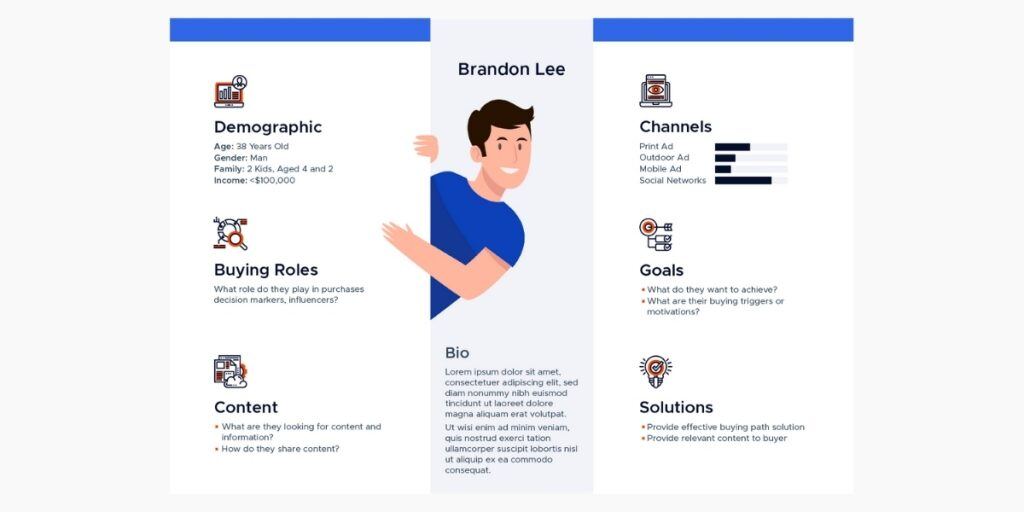
A buyer persona is a semi-fictional representation of your ideal client. The buyer persona profile
allows you to put yourself into your customers’ shoes and understand how they buy, why they buy and what problems they are trying to solve.
And with that understanding it becomes much easier to create relevant messaging and marketing campaigns.
Fun Fact: The first persona ever created was named Kathy and was developed by Alan Cooper in 1983 to help make software more user-friendly.
A Google study highlights that nowadays customers expect brands to provide personalized and relevant experiences in a timely manner.

Source: Think with Google
“Those who invest in creating memorable experiences will win users’ hearts and minds.”
Jason Spero, VP of Global Performance Solutions at Google
When used well, personas prevent you from wasting your marketing efforts attracting people who will never be able to afford, nor have a genuine interest in your product or service.
All in all, the main benefits of using buyer’s personas are:
“Ok, but how do I start?”
Glad you asked! 🙂
Creating your business’ buyer personas for the first time might sound more complicated than it actually is. Let’s see how this process can look like.
Step 1. Talk to your current customers
Your customers are a great place to start. Pick a few of your best customers and sit down to talk to them. Ask them why they chose you, what they enjoy about your offering, where they go for information, what concerns they had prior to purchasing. If you don’t have any clients just yet, it is worth reaching out to a few people that might potentially need your product or service. Make sure you set the stage right by making it clear that you are not typing to make a sell, and want their insights and feedback.
Step 2. Talk to your team
Your colleagues are also a good source of customer insights. Your salespeople in particular can share interesting ideas, anything from what questions prospects typically ask to how the sales process develops. Operations and customer service teams can also bring great ideas to the table, so make sure to check in with them too.
To help you get into the mindset of your potential customers, your efforts should focus on getting insights into your client’s:
If you are unsure what to ask specifically, we put together a list of 67 questions to ask in persona interviews [Research Sheet].
Step 3. Take a look at the data
Some other places that can help you understand your ideal clients better are:
Step 4. Turn raw data into a buyer persona profile
Once you’ve gone through the research process, you’ll have a lot of raw data about your potential and current customers. But what do you do with it? How do you distill all of it so it’s easy for everyone to understand it?
Using a template you can synthesize all the raw data into an easy to read format. Remember that your buyer persona is not a real person (you’re not trying to describe one of your existing customers), but rather a profile that reflects several of your best clients.
You can start off with a simple Buyer Persona Template to stay organized.
Take for example one of our early profiles for Marketing Megan.
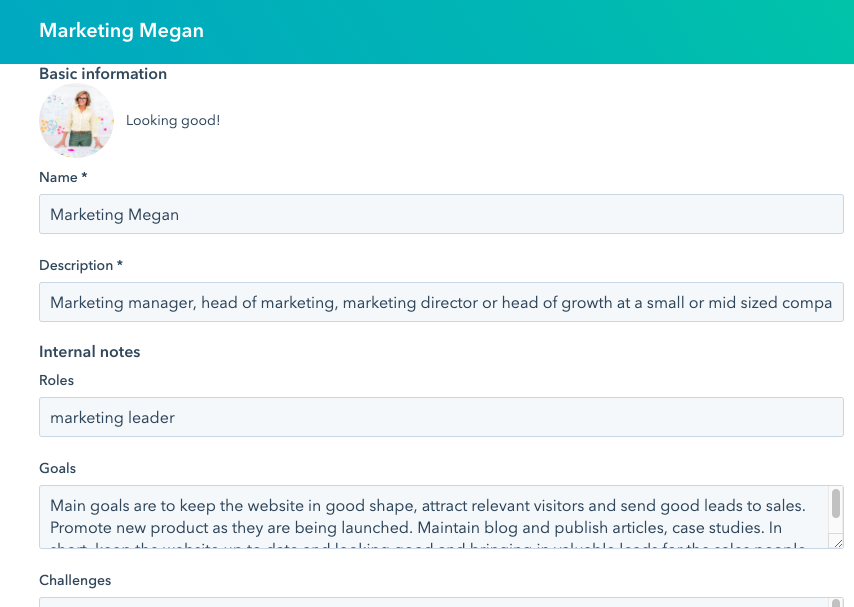
Adding a real picture and name, even real quotes from your customers humanize your personas and help your team when it comes to messaging and brainstorming campaign ideas.
Step 5. Share with your team, get everyone aligned & integrate it into your automation platform
Now it’s time to get your customer-facing team together. Ensuring everyone on your team knows how to best target, support, and work with your customers will help you improve reach, boost conversions, and increase loyalty.
PRO TIP: If you take the time to create negative personas – the people that aren’t a great fit for your business – you’ll have the added advantage of being able to segment out the “bad apples” from the rest of your contacts, lowering cost-per-lead and cost-per-customer.
“How many personas should we build?” you might ask. Well, there is no correct answer.
Depending on how complex your service or product is, how many industries you serve, you might have several personas. If it’s the first time that you develop a buyer persona profile, start small with 2-3 personas maximum. You can always develop more personas later if needed.
The buyer’s journey essentially refers to the stages a customer goes through from becoming aware of a problem (awareness stage) to considering different solutions (consideration stage) to making a purchasing decision (decision stage).
Defining the buyer’s journey is beneficial because:
Usually, the buyer’s journey is fragmented across different devices (mobile, desktop, tablet) and platforms (social media, search engines, your owned media). But when we’re talking about a B2B company things can get even more complex. Your sales cycle might be longer and your prospects might need more nurturing and education before being ready to buy.
Take a look at this excellent infographic Forrest team put together highlighting the complexity of a B2B sales funnel.
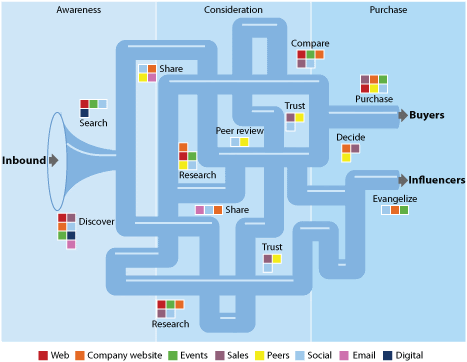
Understanding the customer journey across these touchpoints is essential to the success of any marketing program. Here is an overview of how you could map your content based on your customer’s journey.
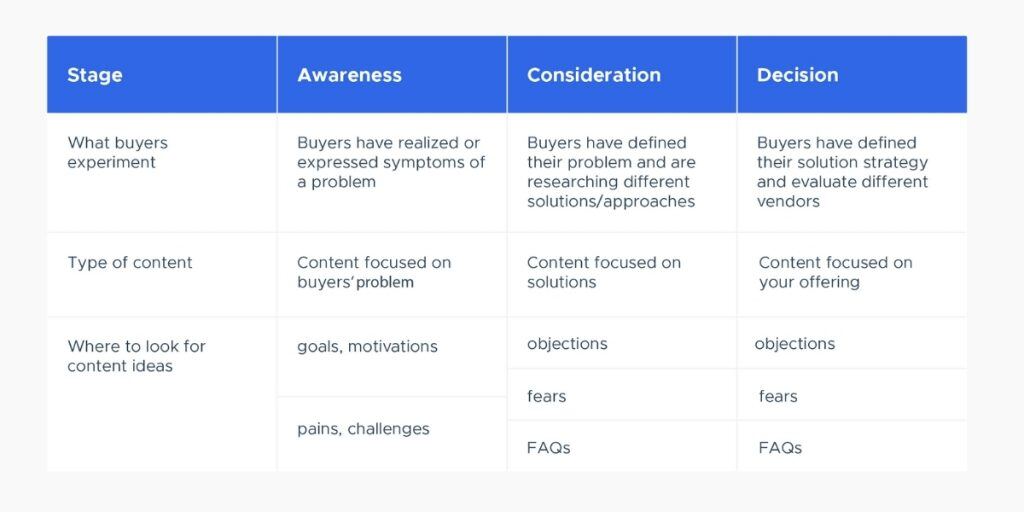
According to Pardot’s State of Demand Generation study, 77% of buyers want different content at each stage of their research, but putting together a coherent content strategy will not happen overnight. A content audit followed by a content plan can put you on the right track.
A content audit describes the process of collecting and analyzing assets on a website, such as web pages, case studies, news, blog posts, or any other type of content you think is relevant (videos, presentation decks, infographics). It helps you keep an inventory of your website and provide insights into which content to create, update, re-write, or delete.
Performing content audits at least once a year can help guide your content marketing strategies into different directions that will appeal to your targeted audiences, improve content for better organic reach, and boost conversion rates.
The first step is to identify the content ideas/core topics fit for each stage of your buyer’s journey: awareness, consideration, decision – essentially the previous step we talked about.
Then move on to create an inventory of your web pages and blog posts; you can list them in a worksheet for easy visualization.
What are we looking for?
Here is an example of how we structure our spreadsheet after we export all links from tools such as Semush, Screaming Frog or Moz.

After you’ve identified core topics your buyers are interested in at each stage of their journey and found the topics you want your business to be known for it’s time to plan your content ideas.
Download these resources and plan your content strategy today: Content Inventory & Content Calendar Worksheet.
Summing up what we tackled so far: you determined who your ideal customers are and created one (or more) buyer persona profile, you know what their buying journey looks like and what questions they have at each stage. You put together a content calendar to address these questions.
It’s now time to tie it all together into your inbound strategy.
As inbound gravitates around content, your inbound strategy will focus on what specific content and strategic conversion paths to create.

In order to build your inbound strategy, you’ll want to cover the following areas:
Would you go on vacation without knowing where you are headed? Most probably not.
The same goes for your inbound strategy: before knowing what route to take, you will need to define where you want to get. Those are your marketing goals and one fundamental aspect is to think in terms of the SMART goals:
Increasing website traffic by 50% and the number of customers by 20% in the next 15 months is an example of such a SMART goal. Aligning your goals with your business is another key element – say you’re focusing on generating website traffic and increasing your Facebook page engagement. While these are nice goals, how will they actually help your company grow and move the needle up?
Therefore you’ll want to think of your goals in terms of leads, marketing qualified leads, sales qualified leads, and customers.
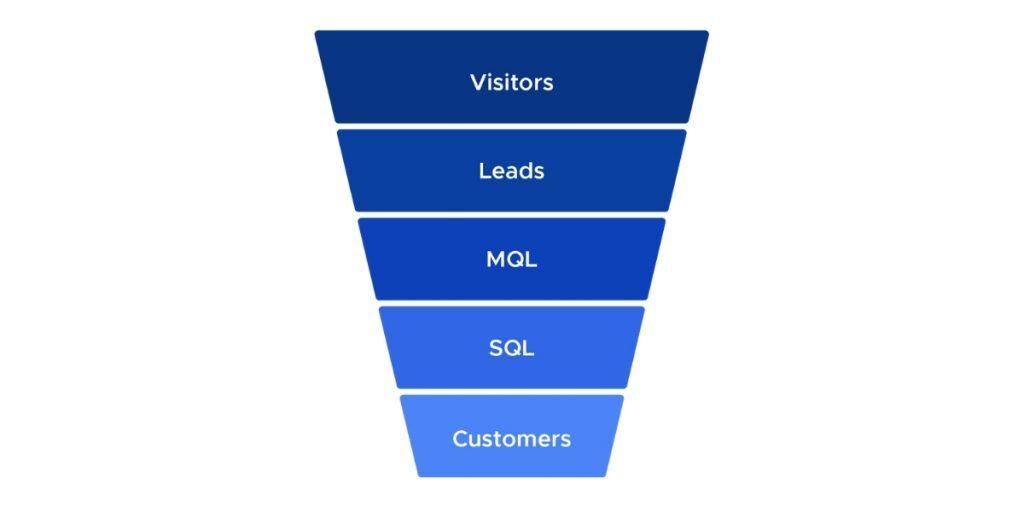
Not sure how to define your numeric goals? One idea is to decide how many customers you want to convert in a given period and then work backwards to determine how many leads, marketing qualified leads and visitors you’ll need to attract to reach your goal.
If you don’t have historical data to compute your own conversion rates, you can use the industry’s benchmarks, to begin with:
We prepared an easy to use Lead Calculator to work out how many leads you need to achieve your revenue goals.
Establishing common ground with sales means that both sales and marketing have a common understanding of:
A lead is a visitor that expresses interest in your company by providing their contact information (email and name at the very least).
Marketing qualified lead (MQL) is a lead that is more likely to become a customer than other leads; shows a higher level of engagement.
A sales qualified lead (SQL) is a MQLs that has been researched & fits your criteria and is ready to have a sales conversation.
You will need to define specifically what MQLs and SQLs mean to your business, and it is best that marketing and sales have a conversation and align around definitions.
MQL can mean a lead that has downloaded a BOFU (bottom of the funnel) piece of content or someone who visited the pricing page repeatedly. SQLs need to fit certain criteria such as the right industry or vertical, a specific company size, a certain sales model. As you can see definitions can vary so it’s best to take the time and think about what would make a lead qualified to receive further marketing content and what would make a lead “sales-ready”.
After you have defined the goals you want to achieve, the next step is to think about how you can achieve those goals – what types of campaigns do you need to get there? Based on whether you need to attract more visits, convert more visitors into leads or both, you can decide which type of campaigns to implement.
Broadly speaking, there are three types of inbound campaigns: traffic acquisition, lead generation campaigns, and lead nurturing.
In order to convert visitors into leads and then MQLs, you’ll need to have sizable website traffic to work with. Considering the visitor to lead conversion rate is anywhere from 1% to 3%, if you get 1,000 visits per month then you can expect to generate anywhere between 10 and 30 leads, and 1.5 to 4.5 MQLs. This doesn’t sound all that great, right?
So if acquiring traffic is a priority for you, there are a few tactics you can employ:
A lead generation campaign has four main elements:
A simplified lead generation flow (also known as conversion path) can look something like this.
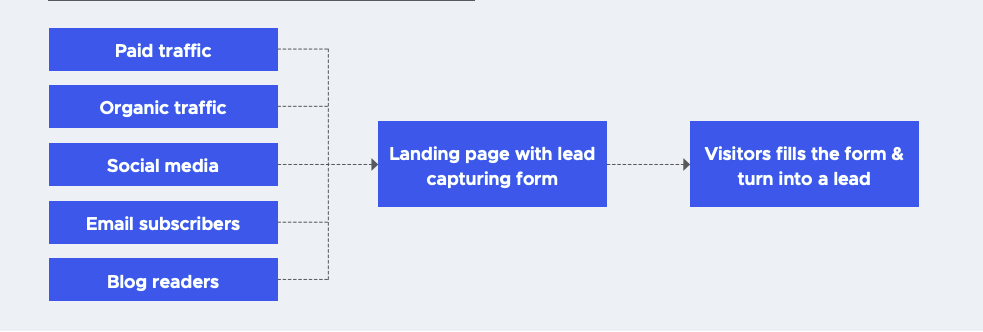
Your content offer can take various shapes:
Remember to create content offers for each stage of the buyer’s journey: top of the funnel (TOFU/awareness), middle of the funnel (MOFU/consideration) and bottom of the funnel (BOFU/decision).
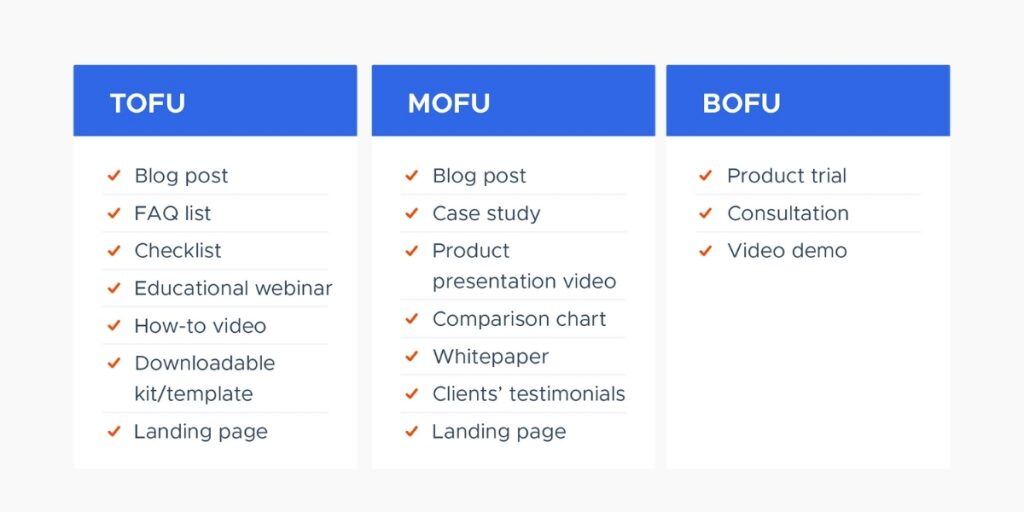
Some of the ways you can promote your content offer are:
According to MarketingSherpa, “61% of B2B marketers send all lead generation directly to sales; however, only 27% of those leads will be qualified.”
What that should tell you is that most of the leads coming through your website need to spend a little bit more time before having a sales conversation; they need nurturing.
As per The Annuitas Group claims nurtured leads make 47% larger purchases than non-nurtured ones.
Essentially that means those people need to spend more time learning about your company and offering.
Your lead nurturing campaigns are not stand-alone campaigns, rather they are connected to your lead generation. Leads generated through a campaign will ideally be segmented and entered into different flows depending on their lifecycle stage.
To effectively nurture your lead you’ll need to:
Segmenting your leads will depend on your type of business and on your qualification criteria, some ideas to help are:
In order to implement effective lead nurturing campaigns, you will need to use an automation platform that will keep track of your leads behaviour and send them automated communication that is relevant and aligned with their actions. There are a number of great automation platforms out there, two that we like in particular and work with are HubSpot and ActiveCampaign.
Taking a peek at what your competitors are doing can give you some ideas of how to differentiate your content and campaigns. Look at the top 3-4 competitors and try to figure out what you can do better or different: do they create only written content? Maybe it’s a good idea to try other formats such as video or webinars. Is there a specific relevant topic they don’t cover?
If you went through all the previous steps of defining your goals, considered the types of campaigns that can help you achieve those goals and looked at what your competitors do, it’s time to build an action plan.
Your campaign plan can look something as simple as this.
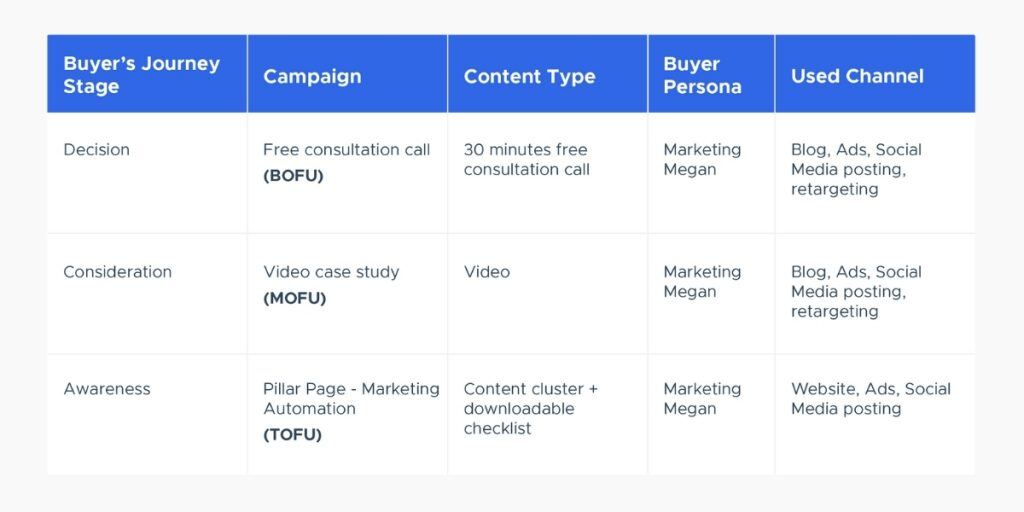
As with any marketing action you take, you need to measure the impact of your campaigns and improve based on what you learn. Marketing is a trial and error activity, you make assumptions, test them in real life, and adjust accordingly.
So to keep your campaigns in check, you can track your KPIs on a weekly basis and A/B test as much as you can – from landing pages, emails to forms, and CTA buttons.
There you have it – an end to end journey of what inbound is all about. If you are new to inbound, starting with building your buyer persona is best. You can then move on to create a content calendar based on the topics your persona is interested in and tie everything into a comprehensive inbound strategy.
If you need help with any inbound marketing activity you can sign up for a free discovery call with us to explore if and how we can help you.
TAGS
Inbound Marketing